|
| Early Office Safes |
Antique Office Safes

Safe with Andrews Patent Combination Lock, American Bank Lock Co.,
New
York, NY, 1841. National Museum of American History,
Smithsonian Institution, Washington, DC
Safes are among the most common items seen in photographs of late 19th century and early 20th century offices.
This exhibit deals primarily with 19th century safes and covers early 20th
century safes briefly near the end.
Early and Mid-19th Century Safes
Until
1820, safes, or
"iron chests" as they were often called, were designed to protect against burglars, but they did not offer substantial protection
against fire. Safes designed to protect their contents against fire were
introduced beginning around 1820, but safes that successfully protected their
contents against major building fires were not marketed until the early
1840s. After that, safes were routinely used in offices to protect against
both fire and burglars. Ads do not say anything about protection against tornadoes. Typically, interior wooden partitions in office safes were designed to hold ledgers
and other papers. In the 19th century, at around $150 to $225 for typical
sizes, safes were the most expensive item
of office equipment.



Left: Single door safe
containing ledgers, M Briggs & Son, Rochester, NY, 1882 ad
Center Left: Large double door safe, American Steam Safe Co., New York, NY
Center Right: Burglar Proof Safe, American Steam Safe
Co., New York, NY
Right: Hall's Fire and Burglar Proof Safe, Hall Safe & Lock
Co., Cincinnati, OH
Turning to the early history of safes, "The first types of English safes were strong wooden boxes, bound with iron hoops. A specimen of the old wooden chest is preserved in the Cathedral of Chichester. It is 9 feet long, 2 feet wide, and 2 feet high, with a thickness of about 2 inches, and is thought to be about 1,000 years old. Wrought-iron chests were used in the store-rooms of country mansions about the beginning of the present [nineteenth] century. At the end of the last century the Carron Company in Scotland, and the Coalbrookdale in England, had introduced cast-iron chests and book safes with single and double doors. These boxes were cast in one piece, about half an inch in thickness, with doors formed in one casting of the same average thickness. This style of safe remained in general use until it was abandoned on account of affording no security in case of fire. For other forms of security, such as alarm systems and security camera systems, browse the web for more information. About 1827, Thomas Milner commenced to make safes with outer cases of strong tin-plate and sheet iron, with an inner lining of the same, forming a chamber all around for the reception of a non-conducting substance composed of hard wood and sawdust mixed with alum. In case of a fire the alum melted, and by damping the sawdust prevented the conduction of heat to the interior of the safe. This may be considered our first fire-proof safe. The safes were understood to be fire-proof only, but not burglar-proof." (Manufacturer and Builder, May 1878, p. 107)
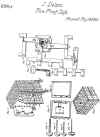 By 1825, Jesse Delano was manufacturing iron chests in New
York City. In 1826, he patented an improvement in fire proof safes "which
consisted in coating the wooden foundation with a composition of equal parts,
clay and lime, plumbago and mica, or saturating the wood in a solution of potash
lye and alum, to render it incombustible. These were generally used in
this country [the U.S.]." (One Hundred Years'
Progress of the United States, 1870, pp. 396-97) "The first safes
manufactured in this country were lined with wood; the old-fashioned
'knob-chests,' as they were called, were simply wooden boxes covered first with
thin sheet-iron, then banded and strapped, and the whole nailed fast with large
nails, having prominent knobs or cast-iron heads. The original method of
preparing wood as a lining for safes was to saturate or soak it with salt water,
and as wood is absorbent, it retained this saturation for some time." (Fighting
Fire for Twenty-Six Years, Comprising a History of Herring's Patent Champion
Safes, 1867, p. 9) Delano's patent,
which bears the number x-8356, was reissued in 1834. A copy of the patent
diagram is provided to the right. Delano and his sons manufactured safes
in New York City until 1859.
By 1825, Jesse Delano was manufacturing iron chests in New
York City. In 1826, he patented an improvement in fire proof safes "which
consisted in coating the wooden foundation with a composition of equal parts,
clay and lime, plumbago and mica, or saturating the wood in a solution of potash
lye and alum, to render it incombustible. These were generally used in
this country [the U.S.]." (One Hundred Years'
Progress of the United States, 1870, pp. 396-97) "The first safes
manufactured in this country were lined with wood; the old-fashioned
'knob-chests,' as they were called, were simply wooden boxes covered first with
thin sheet-iron, then banded and strapped, and the whole nailed fast with large
nails, having prominent knobs or cast-iron heads. The original method of
preparing wood as a lining for safes was to saturate or soak it with salt water,
and as wood is absorbent, it retained this saturation for some time." (Fighting
Fire for Twenty-Six Years, Comprising a History of Herring's Patent Champion
Safes, 1867, p. 9) Delano's patent,
which bears the number x-8356, was reissued in 1834. A copy of the patent
diagram is provided to the right. Delano and his sons manufactured safes
in New York City until 1859.


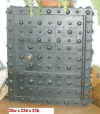
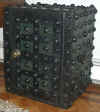

Iron Chests made by Jesse Delano 1826-1830s
Three images on left of double door safe courtesy of Frank Vecchi
Next two images to the right show two different single door safes.
Last photo to right shows the knob on the safe to the immediate left of this
photo.
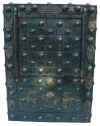
Iron Chest made by Magaud de Charf, Marseille, France
"After Mr. Delano, C. J. Gayler began the safe manufacture, and in 1833 he
patented his 'double' fire-proof chest. This consisted of two chests, one
so formed within the other as to have one or more spaces between them, to
inclose air or any known non-conductors of heat. In the same year, one of
these double chests was severely tested in a large building that was entirely
destroyed by fire. The chest preserved its contents in good order.
This excited the public admiration, and one enthusiastic writer described it as
a 'Salamander,' which name has ever since been popularly applied to safes. [According to mythology, salamanders could survive and extinguish fires.]
The majority
of the so-called 'safes' in use at the time of the great fire in New York in
1835 were simply iron closets, and were of little protection against the
devouring element. There were then about sixty of Gayler's double chests
in use, and a few of these preserved their contents. Soon after, John
Scott obtained a patent for the use of asbestos for fire-proof chests." (One Hundred Years'
Progress, pp. 396-97)

Gayler's Patent Double Fire Proof Wrought Iron Chests
& Safes, NYC, 1833.
In 1833, the agent for Gayler's patent double fire proof wrought iron chests and safes advertised that it had 50 models weighing between 300 pounds and 5,000 pounds and suitable for banks, insurance offices, town records, and merchants. The agent stated that "The great iron chest recently set up in the Savings Bank, Chambers Street, New York, was made in the [Gayler] manufactory. It is the largest in the United States, being 10 feet high, 21 feet wide, and weighs 11,000 pounds." On a 1834 billhead, C. J. Gayler of New York City described himself as a "manufacturer of fire proof iron chests and bank safes." In 1835, C. J. Gayler was an "iron chest maker" and J. Delano & Sons were "iron chest makers" on Water Street in New York City. ("The Conflagration," New York Herald, Dec 18, 1835)
In fact, none of the safes marketed through the 1830s provided
reliable protection against the heat of intense fires. Scientific American
(June 11, 1853) reported that "the fire of 1835 in New York had proved that
the old fashioned safe was perfectly worthless." The 1841 safe
pictured at the top of this page is not heat proof; it has single walls rather than double walls
filled with insulation.
"The next period in safe-making is now known as the plaster of Paris
age--the water being this time retained by plaster or hydraulic
cements." Beginning in
1830, Daniel Fitzgerald of New York figured out how to design a reliable fire
proof safe using plaster of Paris as an insulating material. Fitzgerald's 1836
patent application was denied because personnel of the
Patent Office were protecting an inventor of an earlier technology. " In
1837, Benjamin Sherwood obtained U.S. Patent No. 190 for a revolving interior
[cylindrical] safe [inside a larger revolving cylindrical safe], filling
the spaces with plaster of Paris and charcoal." (One Hundred Years'
Progress, pp. 396-97) "Sherward's [sic] Revolving Safe,"
described as "A double cylinder safe, one revolving within the other as an
additional security against rogues and fire," and by judges as "A good
article," was exhibited at the 1837 exhibition of the Massachusetts
Charitable Mechanic Association MCMA.
In 1839, Thayer & Edwards, Boston, MA, exhibited an iron safe at the second
MCMA exhibition. In 1841 Thayer & Edwards, and then in 1844 its
successor company Edwards & Holman, Boston, MA, exhibited "Salamander
Safes." at the third and fourth MCMA exhibitions. Finally,
with the assistance of Enos Wilder, Fitzgerald was granted U.S. Patent No. 3,117
on June 1, 1843, for an "improvement in fire-proof chests and safes,"
specifically the construction of what the patent identifies as a
"Salamander Safe" made of heavy iron plates and filled with a three-inch layer of
plaster of Paris in liquid form.
Fitzgerald assigned the patent to Enos Wilder, who left it to his heir, Benjamin
G. Wilder, and it became known as the "Wilder patent." Safes made
using the technology in the Wilder patent proved effective against fire, and
earlier technologies were made obsolete.
![]()
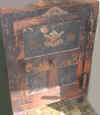

B. G Wilder Patent Salamander Safe, New York, NY.
Courtesy Kevin Forrey
Adams Hammond & Co. Patent Salamander Safe
Rich & Co. Salamander Safe, dated 1842
The name plaque on this safe is pictured below.
Photos courtesy of Christopher C. Cenac
Commercial production of safes using the technology in the Wilder patent began in 1840 or shortly before. According to one account, "a citizen of New York named Crandall Rich, associated with himself two others named Roff and Stearns, and commenced the manufacture of these safes, making an arrangement with Wilder, that if he obtained the patent, they were to pay him for the use of it, which was afterwards done. These parties, Rich & Co., soon discovered that the composition as invented by Fitzgerald damped the books and papers; therefore an improvement was made and patented by Rich & Co., the result of which has been that in the great fire of New York in 1845 property to the amount of thousands of dollars was preserved in these safes, while safes of every other description were totally destroyed. In a period of twelve to fifteen years [1841-53 or 1838-53], no failure has ever taken place, and they are in such general use that scarcely a fire happens without one of these safes being tested." (Scientific American, June 11, 1853)
Competing safe technologies were tested in 1840. "The great trial of safes at Coffee-house Slip, foot of Wall street, New York, in 1840, in which all the leading fire-proof chests then made were destroyed, while the newly introduced Salamander bore off the palm of victory, was witnessed by Mr. Herring." (Fighting Fire, p. 13) According to another account, "About 1841, Mr. Silas C. Herring became interested in Wilder's safes, first as agent and afterwards as a manufacturer. In 1844, the safes under this patent were made by Mr. Herring." Herring agreed to pay Wilder a royalty of one cent per pound for the right to be the exclusive seller of Wilder's Salamander safes in New York City. (One Hundred Years' Progress, p. 397) In 1841, these safes were $40 to $250, and they were produced at the rate of about three a week. (Fighting Fire, p. 14)
About this time, Enos Wilder filed a patent
infringement suit against Charles Gaylor (presumably an alternative spelling of
Gayler) and another against
Crandall Rich, Almon Roff, John Stearns, and Azor Marvin. In the second of
these actions, "After a protracted lawsuit, a compromise was effected
by which both parties continued to manufacture." (One Hundred Years'
Progress of the United States, 1870, p. 397) In 1847, J. E. Wilder exhibited
a Salamander safe at the fifth MCMA exhibition. Also, in 1847 Adams &
Hammond, the owner of the
Wilder patent (and itself an exhibitor of iron fire-proof safes in 1844 and 1847
at the fourth and fifth MCMA exhibitions in Boston, MA.) sued Edwards & Holman for producing safes from 1843 to 1847 that infringed that
patent. (Levi Woodbury, "Charge in the Case of Adams
& Hammond vs. Edwards & Holman," Writings of Levi Woodbury,
1852, Vol. 2, p. 286.)
In 1850, Salamander safes were exhibited by at the sixth MCMA exhibition by
three parties, John E. Wilder, William Adams, and Denio, Cheney & Co, all of
Boston, MA.
Silas C. Herring exhibited fire-proof safes
at the Crystal Palace in London, England, in 1851 and won an award. "We
must not omit to mention here the interest universally created by the salamander
safes deposited by Silas C. Herring of New York. The metal of the safe consists
of the stoutest and toughest wrought bar and plate iron, the space between the
inner and outer surfaces being filled with a composition, of which plaster of
Paris is the principal ingredient. Several attempts have been made here to
burn this safe, but after laying in the fire for forty hours, red-hot,
the contents came out uninjured." (Scientific American, Aug. 16,
1851, p. 378) Chubb & Son also exhibited fire-proof safes at the Crystal
Palace in 1851. Ca. 1853, Silas C. Herring & Co. advertised single door safes
ranging from $40 (for a 12" x 8" x 9" model) to $200 (32" x
27" x 15") and folding door safes ranging from $175 (22" x
32" x 16") to $625 (64" x 51" x 19").

Left: Silas C. Herring, c. 1851
Right:
Chubb and Son exhibited London 1851, Paris 1855
Competing safe makers tried many alternative insulating materials, "but none proved
as effectual as hydrated plaster of Paris, which, under the influence of intense
heat, gave up its water of combination, and forming an atmosphere of steam in
the inner portion of the safe, protected the books or papers from
destruction. It was found, however, that the plaster after a time gave up
a part of its water of combination, and not only made the interior of the safes
mouldy and damp, but rusted the plates of iron till they were eaten
through." In 1852, Spear discovered an alternative to plaster of
Paris that did not cause dampness, and in 1854 Herring began to use Spear's invention. "B.
G. Wilder had meantime commenced the manufacture of
safes under his patent; and the successors of Messrs. Roberts & Rich, under
several firm names, as Rich & Roff, Roff & Stearns, and Stearns &
Marvin, also manufactured the Wilder safe." (One Hundred Years' Progress,
p. 397) In 1867, Herring claimed that since 1841 it had manufactured
more than 30,000 safes. (Fighting Fire, p. 14) Also in 1867,
Herring, Farrel & Sherman, New York, won a bronze medal for fire and
burglar-poof safes. (Reports of the Commissions to the Paris Universal
Exposition 1867, Vol. I, Washington, DC, 1870, p. 302)

Between
1840 and 1860, numerous companies in New York City
and Boston manufactured fire-proof Salamander safes using the Wilder patent.
Safes made by a number of these
manufacturers have metal plaques with wording such as "Wilder's Patent Salamander Safe
1842," "Wilder's Improved Patent
Fire-Proof Salamander Safe," or "Improved Patent Salamander Safe. C. Rich. N. York.
1842." Shortly before April 1844, a cartoon showed a man with provisions inside a
Salamander safe labeled "Patent Fire Proof
Chest."


Left: C. Rich & Co. Salamander Safe Plaque.
Courtesy of Doug Hamann.


Pin key, lock, and name plate from S.C. Herring Wilder Patent
Salamander Safe
Photographs courtesy of Tom Gazda
There was a substantial amount of litigation relating to the Wilder
patent from soon after it was awarded until at least 1869. Based on the dates of
published references to Salamander safes, it appears that these safes were most
popular during the 1840s and 1850s. However, the Wilder Salamander Safe Co. was
doing business in New York City in 1870, and we have seen a few references to
Salamander safes that were published in the early 1870s.
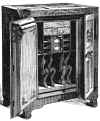 US
Patent No. 12,594, which covers another method of insulating safes, was
awarded to Richard Holmes and William H. Butler on Mar. 27, 1855. This patent
claimed "a new and useful improvement in alum fillings of safes, combining
with the alum filling an alkali, in such proportions that the alum, in becoming
heated or melted has a part of its acid neutralized by the action of the
alkali." Also, "the said filling is interspersed with and
supported or restrained from settling down by cells of porous material"
(formed by filling the walls with pieces of bricks along with a mixture of clay,
alum, and an alkali. A fire-proof safe made by Holmes, Valentine &
Butler, New York, NY, which incorporates this technology, is illustrated to
the right. (Scientific American, Nov. 17, 1855) A second safe based
on this patent is pictured below.
US
Patent No. 12,594, which covers another method of insulating safes, was
awarded to Richard Holmes and William H. Butler on Mar. 27, 1855. This patent
claimed "a new and useful improvement in alum fillings of safes, combining
with the alum filling an alkali, in such proportions that the alum, in becoming
heated or melted has a part of its acid neutralized by the action of the
alkali." Also, "the said filling is interspersed with and
supported or restrained from settling down by cells of porous material"
(formed by filling the walls with pieces of bricks along with a mixture of clay,
alum, and an alkali. A fire-proof safe made by Holmes, Valentine &
Butler, New York, NY, which incorporates this technology, is illustrated to
the right. (Scientific American, Nov. 17, 1855) A second safe based
on this patent is pictured below.
This safe labeled "Marvin & Co. Valentine &
Butler. Alum Patent. Mar. 27, 1855"
Photographs courtesy of Tom Gazda
Offices may have been more concerned about protecting their
books and papers from fire than burglars, but there was demand for burglar-proof
safes. In England, Chubb patented a burglar proof safe in 1833. In the mid-19th
century in the U.S., "Lillie's safes were highly commended for this
purpose, he using thick slabs of chilled cast iron, and flowing cast iron over
wrought iron ribs in their construction. It was found after a time, however,
that the burglars succeeded in drilling these sufficiently to blow them up in a
few minutes. Messrs. Herring & Co. a few years since [that is, a few years
before 1870] adopted the plan of making their burglar-proof safes externally of
boiler-plate wrought iron, with an inner safe of hardened steel, and then filled
the space between with a casting of Franklinite, the hardest of all known
metallic ores, which in casting was incorporated with rods of soft steel, those
on one side running vertically, and those on the other horizontally. These
castings resist the best drills for many hours. This has, in connexion
with the burglar-proof locks, proved the most complete protection against
burglars yet invented." (One Hundred Years' Progress of the United
States, 1870, p. 397)
Late 19th Century Safes
Morse Safe, Boston, MA, 1872
Three photos of a safe made by the Barnes Safe & Lock
Co., Pittsburgh, PA, 1871.
Photo on the left shows the closed safe; photo in the middle shows the safe
with the outer doors open; photo on the right shows the safe with the inner
doors open as well.
See below for an 1871 advertisement by the Barnes Safe & Lock Co.
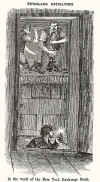

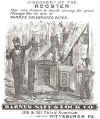

![]()
From Left:
1. Burglars attempting to open a Herring
safe, 1867
2. Herring, Farrel & Sherman safe opened in 29 minutes with burglars'
tools, published 1868
3. Discovery of a frozen rooster in a Barnes safe after the
Great Chicago Fire, 1871
4. Demons with powder and nitro-glycerin attempting to open
a Butler patent safe, Diebold Safe & Lock Co.
5. Transporting a safe, Hall's Safe & Lock Co., Cincinnati,
OH, 1872
6. Trade Card, Kerr's Cotton Thread, Kerr & Co., New York,
NY.



![]()
![]()

Herring & Co. safes, Boston, MA, and NY, NY,
established 1841, 1875 advertisement.
For information on safes displayed at the 1876 Centennial Exhibition, click here and
then scroll down.

Whitfield's Light Fire-resisting Safe, 1880
This appears to be an economy (light weight, low cost) safe.
Early 20th Century Safes
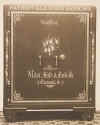
![]()
Safes made by the Victor Safe & Lock Co., Cincinnati, OH,
c. 1904.
The first four images are of one safe. The next image shows a larger safe
of a similar style. The last two images show a third safe.

"Fire-Proof" Safe, Cary Safe Co., Buffalo, NY
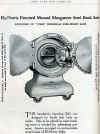
Ely-Norris Patented Manard Manganese Steel Bank Safe enclosed
in York Safe & Lock Co. Spherical Fire-Proof Safe, 1918 York catalog, York,
PA.
Cabinet safes were designed to hold modular filing cabinets
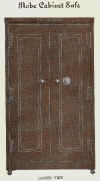
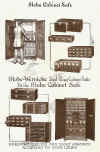
Globe Cabinet Safe, closed and open views, Globe-Wernicke,
1911.

Cabinet Safe, The Macy Co., 1917
Cabinet safes similar to those above were advertised at least as late as 1928.

